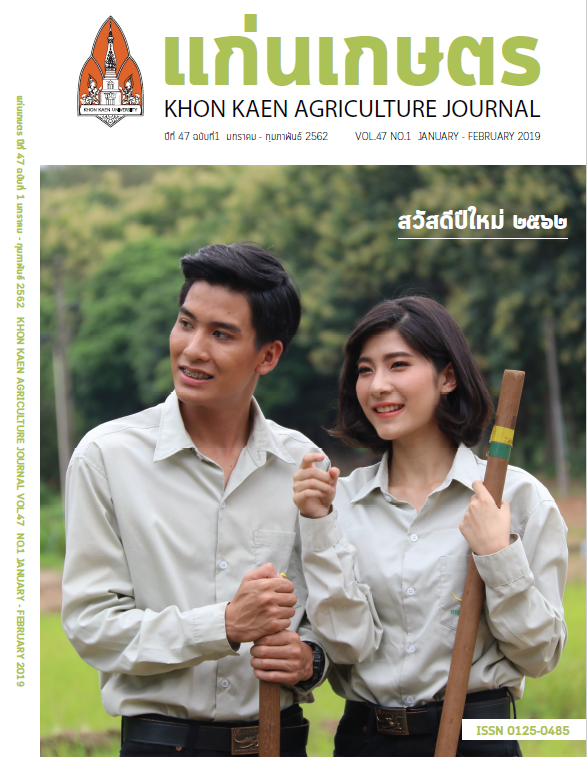ผลของการขาดน้ำที่ช่วงอายุต่างๆ ต่อการเจริญเติบโตและปริมาณเบต้าแคโรทีนในคะน้าฮ่องกง
Main Article Content
บทคัดย่อ
การศึกษาการขาดน้ำในช่วงระยะเวลาต่างๆมีผลต่อการสร้างต้านออกซิเดชันในพืชหลายชนิด แต่ยังไม่มีการศึกษาในคะน้าฮ่องกง ซึ่งเป็นพืชที่นิยมบริโภคจำนวนมาก ดังนั้นการศึกษานี้จึงเน้นการศึกษาผลของการขาดน้ำในช่วงการเติบโตระยะต่างๆ ที่ส่งผลต่อการเจริญเติบโต และปริมาณเบต้าแคโรทีนในผักคะน้าฮ่องกง ที่ปลูกในดินบนของชุดดินกำแพงแสน (Typic Haplustalfs) โดยทดลองภายในโรงเรือนมุ้งตาข่ายที่มีอุณหภูมิ และความชื้นในช่วงเวลาทดลองเป็น 30-31OC และ 70-75% ตามลำดับ วางแผนการทดลองแบบสุ่มสมบูรณ์ (Completely Randomized Design, CRD) จำนวน 10 ซ้ำ 4 ตำรับการทดลอง ได้แก่ ตำรับควบคุม T0: ให้น้ำตลอดการปลูก T1: งดให้น้ำระยะเริ่มปลูกที่อายุ 19-21 วันหลังปลูก T2: งดให้น้ำในระยะเจริญเติบโตที่อายุ 35-37 วันหลังปลูก และT3: งดให้น้ำระยะโตเต็มที่ ที่อายุ 45-47 วันหลังปลูก ผลการทดลอง พบว่า T3: ให้ความสูง น้ำหนักสดและน้ำหนักแห้งใกล้เคียงกับตำรับควบคุม แต่จำนวนใบ และปริมาณสารเบต้าแคโรทีนมีมากที่สุดอย่างมีนัยสำคัญทางสถิติ
Article Details
เอกสารอ้างอิง
เฉลิมพล แซมเพชร. 2535. สรีรวิทยาการผลิตพืช. ภาควิชาพืชไร่. คณะเกษตรศาสตร์มหาวิทยาลัย เชียงใหม่.
สุนิสา ประไพตระกูล. 2551. คู่มือนักวิชาการส่งเสริมการเกษตร พืชตระกูลกะหล่ำ (คะน้า, ผักกวางตุ้ง). สำนักส่งเสริมและจัดการสินค้าเกษตร กรมส่งเสริมการเกษตร.
สำเภา แก้วสระแสน, มัณฑณา สุจริต, จารึก สินธุรัตน์ และวัชรี กองแก้ว. 2559. การทดลองหาปริมาณน้ำใช้ที่เหมาะสมของคะน้า ปีที่ 2 ใน รายงานผลการวิจัยของสำนักวิจัยและพัฒนา สํานักบ ริ ห า ร จั ด ก า ร น้ำแ ล ะ อุ ท ก วิ ท ย า กรมชลประทาน สวพ.06/2559.
ทัศนีย์ อัตตะนันท์ และ จงรักษ์ จันทร์เจริญสุข. 2542. แบบฝึกหัดและคู่มือปฏิบัติการวิเคราะห์ดินและพืช. ภาควิชาปฐพีวิทยา คณะเกษตร มหาวิทยาลัยเกษตรศาสตร์, กรุงเทพฯ.
อายุรวัฒน์เวชศาสตร์. 2559. 21 สรรพคุณ...ประโยชน์ของผักคะน้า. แหล่งข้อมูล: http://sukkaphap-d.com/21-สรรพคุณ_ประโยชน์ของผัก เข้าถึงเมื่อ 19 มิถุนายน 2561
อินทิรา ขูดแก้ว. 2560. ความเครียดของพืช. แหล่งข้อมูล : http://biology.ipst.ac.th/?=3361. เข้าถึง 12 มีนาคม 2561.
Bouchereau A., N. Clossais-Besnard, A. Bensaoud, L. Leport and M. Renard. 1996. Water stress effects on rapeseed quality. European Journal of Agronomy 5: 19-30.
Bray, R.A. and L.T. Kurtz. 1945. Determination of total organic and available form of phosphorus in soil. Soil Sci. 59:39–45.
Cornic, G. 2000. Drought stress inhibits photosynthesis by decreasing stomatal aperture-not by affecting ATP synthesis. Trends in Plant Science 5:187–188.
Gee, G.W. and J.W. Bauder. 1986. Particle–sized analysis, pp. 383–411. In: A. Kulte et al. (eds.). Method of Soil Analysis, Part 1. Physical and Mineralogical Methods. 2nd Edition. Agronomy, No. 9. Amer. Soc.Agron. Inc., Madison, WI.
Germchi S., F. Shekari, M.B. Hassanpooraghdam, M.B. Khorshidi Benam and F. Shekari. 2010. Water deficit stress affects growth and some biochemical characteristics of rapeseed (Brassica napus L.). Journal of Food, Agriculture & Environment 8:1126-1129.
He, J.X., J. Wang and H.G. Liang. 1995. Effects of water stress on photochemical function and protein metabolism of photosystem II in wheat leaves. Physiologia Plantarum 93, 771–777.
Kumar, A., J. Elston and P. Singh. 1994. Leaf area growth of two Brassica species in response to water stress. Crop Res. 8:594-602.
Matsuzoe, N. K. Zushi and T. Johjima. 1998. Effect of Soil Water Deficit on Coloring and Carotene Formation in Fruits of Red, Pink, and Yellow Type Cherry Tomatoes. Journal of the Japanese Society for Horticultural Science 67:600-606.
Mohammadkhani, N. and R. Heidari. 2007. Effects of Water Stress on Respiration, Photosynthetic Pigments and Water Content in Two Maize Cultivars, Journal of Biological Sciences.10: 4022-4028.
National Soil Survey Center. 1996. Soil Survey Laboratory Methods Manual. United States Department of Agriculture, Natl. Soil Surv. Cent., Soil Survey Investigation No.42, Version 3. 693 p.
Nagata, M. and I. Yamashita. 1992. Simple method for simultaneous determination of chlorophyll and carotenoids in tomato fruit. Nippon Shokuhin Kogyo Gakkaishi 39: 925-928.
Ördög V. and Z. Molnár. 2011. Plant Physiology. Digital textbook library. Accessed June 21, 2018
Pietrini, F., M.A. Iannelli and A. Massacci. 2002. Anthocyanin accumulation in the illuminated surface of maize leaves enhances protection from photo-inhibitory risks at low temperature, without further limitation to photosynthesis. Plant, Cell and Environment 25: 1251–1259.
Pratt, P.F. 1987. Potassium, pp. 234–237. In C.A. Black (ed.). Methods of Soil Analysis, Part 2. Chemical and Microbiological Properties. 2nd Edition. Agron. Monograph No.9. Amer. Soc. of Agron. Inc., Madison, WI.
Prochazkova, D. and N. Wilhelmova. 2011. Antioxidant protection during abiotic stresses. In Handbook of Plants and Crop Stress (M. Pessarakli ed.). CRC Press.
Taylor and Francis Group. New York. Reiss C. 1994. Experiments in Plant Physiology. Prentice Hall, New Jersey.
Sharma, P., A. Bhushan, and R.S. Dubey. 2011. Oxidative stress and antioxidative defence system in plants growing under abiotic stresses. In Handbook of Plants and Crop Stress (M. Pessarakli ed.). CRC Press. Taylor and Francis Group. New York.
Vandecandelaere, E., F. Arfini, G. Belletti and A. Marescotti. 2010. Remuneration: marketing a arotenoids in higher plants. Physiologia Plantarum 83: 702–708.


